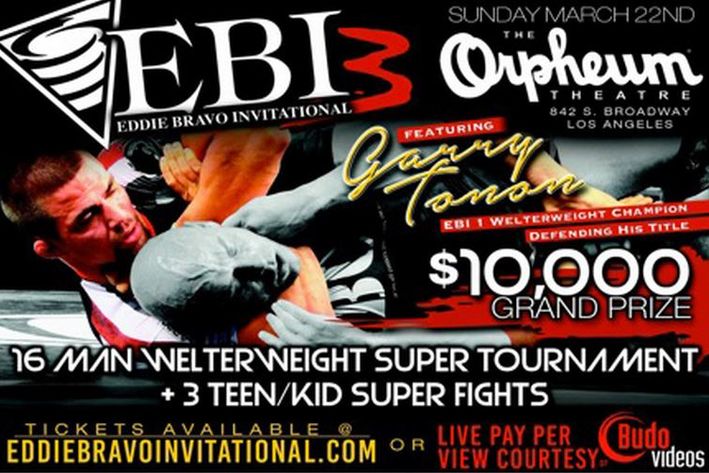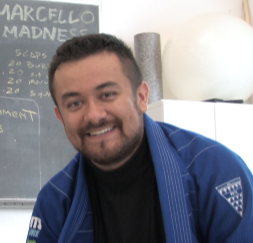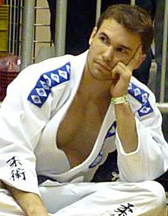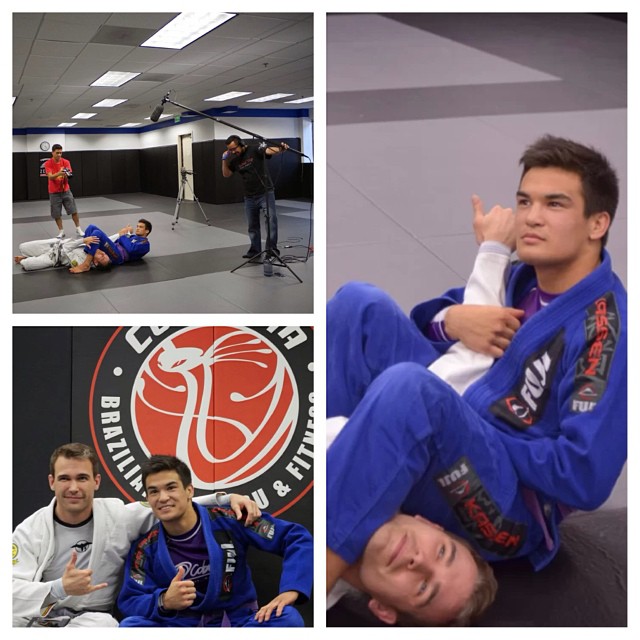 It’s a shame that the headlines leading out of the third incarnation of the Eddie Bravo Invitational had more to do with the behind the scenes business dealings of the sport, rather than the actual practice of jiu-jitsu itself.
But such is jiu-jitsu. We all want the sport to grow and the players to be compensated accordingly—and, as it turns out, still have a ton of differing opinions on how all of that should be carried out. As a result, statements about statements, rampant speculation about dealings pretty much no one has any real clue about, and continued rhetorical nonsense sadly divert the attention away from a series of matches (and the very talented athletes involved in said matches) that truly merit some attention.
It’s a shame that the headlines leading out of the third incarnation of the Eddie Bravo Invitational had more to do with the behind the scenes business dealings of the sport, rather than the actual practice of jiu-jitsu itself.
But such is jiu-jitsu. We all want the sport to grow and the players to be compensated accordingly—and, as it turns out, still have a ton of differing opinions on how all of that should be carried out. As a result, statements about statements, rampant speculation about dealings pretty much no one has any real clue about, and continued rhetorical nonsense sadly divert the attention away from a series of matches (and the very talented athletes involved in said matches) that truly merit some attention.
Because if we’re talking about EBI 3 on it’s own merit, there’s plenty to talk about.
Days before the event, invitational namesake—and 10th Planet Jiu-Jitsu founder—Eddie Bravo hit the rounds and made the intentions of his current passion project very clear: the goal of the Eddie Bravo Invitational is to get jiu-jitsu on network television.
It’s a bold declaration and one that the sport seems to be inching closer to each day (or so the optimistic of us keep telling ourselves).
Still the question at hand seems to be: is EBI ready for network television?
If we’re basing this purely on demonstrated athletic talent and the display of an alternative to the norm of sport jiu-jitsu, then yes. EBI has carved out a niche unto itself that takes the difficult task of staging a 16 man tournament and making it feel fresh. Utilizing a unique format and overtime ruleset (a tiebreaker system again designed to culminate in a finish), the event manages to extract a set of performances out of its competitors that you actively do not see at other invitationals/simulcast jiu-jitsu events.
Then again, that might also be because each submission in regulation can potentially net them $2,500, but incentive is hardly a bad thing (especially for spectators).
At the very least, EBI sets itself apart from other organizations through a few critical avenues.
For one, the athletes seem game to keep the action fast and submission-oriented. While a lot of organizations talk about putting a premium on a “finish,” EBI is one of the few formats that delivers on it in record time. Many of the submissions came within the three to four minute mark, as competitors showed they were less concerned about finding a position to stall or safely sit in and more about initiating the chase. And when it works, the exchanges are nerve-wracking (if you’re a participant and haven’t worked your heel hook defense, you should probably stay home).
The accelerated effort by the athletes also seems to lead to an accelerated pace for the event. To put things in perspective, eighteen matches took place during this three hour plus event—which is nearly three times the amount of matches for roughly the same price as Metamoris, with approximately forty percent more submissions (those are just the facts).
Additionally, EBI is also not short on star power. People like Richie “Boogeyman” Martinez, Eddie “Wolverine” Cummings, Nathan Orchard, and Josh Hinger are certifiable rock stars who thrive in fast-paced formats like this (while EBI 3 standouts Darragh O’Conaill and Karen Darabedyan were given a great avenue to show off their considerable skill). Their precision for attacks and ability to transition are truly things of beauty.
Which is why even a bold move like adding a “starring” credit to the marquee pays off in dividends. Giving Garry Tonon top billing is a move that, frankly, you don’t really see too much from rival organizations. In a 16 man tournament where anyone can have a bad day, it’s logistically a risky endeavor to single out one person.
However, in Tonon’s case, the placement of his name in bold letters comes with good reason.
Garry puts on a show.
As the past few months have shown, it doesn’t matter if he has a match against a relative newcomer, a seasoned pro or even a current teammate (thank you, Garry and Eddie for giving us more than a gentleman’s agreement to the next round), Tonon will make a match worth your while. Now a two-time welterweight champ, it is easy to see why he has become the epicenter of all things exciting in jiu-jitsu. With a mix of definitive finishes and matches that showed a gritty resolve in the toughest of spots, Tonon earned every bit of having his name on the marquee.
That said, you know your bench of talent is deep when your champion doesn’t even get the biggest ovation of the night. That honor went to the stars of one of the kids super fights, Grace Gundrum and Alyssa Wilson, whose matches alongside Demian Balderrama, Jacob Harris, Jessa Kahn, and Cora Sek prove that not only is the future of the sport in good hands, but that it also looks terrifying. If this is how good their jiu-jitsu is now, just imagine how much better these kids are going to get as they progress.
The inclusion of three kids super fights ended up being one of the highlights of the evening’s festivities, as the stars of tomorrow proved they were capable of putting on matches that were equally (if not more) entertaining than their adult counterparts. If you haven’t already, please take a look at the very fun match between Gundrum and Wilson right here:
Go ahead. I’ll wait.
However, going back to our earlier prompt of being ready for network television, there are a few considerations to explore:

I am a huge fan of the organization’s commitment to showcase new talent. EBI is one of the few jiu-jitsu tournaments that puts new talent (of varying degrees of skills and specialties) on the same mats with established names to create interesting, if not sometimes unexpectedly entertaining stylistic match ups. Nonetheless, if we’re talking network level sports, we’re going to need narratives. The introduction to the athletes is an important tool in describing their own journeys to audiences who often have little understanding or comprehension of the sport. The more audiences understand the athlete, the more they’ll tune in.
Additionally, in terms of venue, while the Orpheum Theatre put jiu-jitsu front and center of a large stage, the set up really seemed to limit the number of angles that the camera could capture the action. While simplifying the set up, it also makes it harder to get the angles that compliment the ridiculously fast and furious style displayed by many of the athletes.
Finally, for the love of everything holy, would it kill one organization to know how to properly sign off on a broadcast? The commentating team did a just fine job talking us through the matches, but at the end of the evening a wrap-up to close out the show seemed more like an afterthought—as the three members of the commentary team struggled to find the words to sum up the experience. Moreover, while the live audience seemed thrilled by the matches, they jumped out of their seats rapidly thinking the show was over. By the time someone came out to give finals participants, Tonon and Hinger, the opportunity to talk about their experience, only a fraction of the audience seemed aware this was part of the protocol. If the live audience’s evacuation is any indication for spectator interest (it is), it’s a good indication they want the close of a show to be directed by the commentary team who have their short soundbites ready to encapsulate their experience.
That last one might not seem like a major consideration to the everyday jiu-jitsu fanatic, but—if we’re talking about getting this on TV—presentation is everything. Though it should be noted, EBI is hardly alone of being guilty of this.

Nonetheless, watching the progression from EBI 2 to EBI 3 is one that signals hope. While EBI 2 had a night club vibe that staged not one, but two sixteen man tournaments to an occasionally rowdy audience (that seemed to wane as the event made its way into the early part of the next morning), EBI 3 demonstrated that the organizers are ready to make adjustments to improve the overall audience experience. And for it’s first time airing on internet television (thanks to the folks at Budo Videos), it’ll be interesting to watch as they continue to adjust for the experiences for those watching at home as well.
While we wait for the next EBI, several other tournaments and events will come and go. With more options will come more dealings, as competition will breed more changes to the headline narratives. Even though it’s fun to entertain the headlines from time to time, for those of you already sick of the politics dominating your newsfeeds, I offer you this following consideration:
As more competition will enter the fray, your voice will hold more sway than ever before. If you care more about actual matches than gossip, then seek out those matches. And whatever it is that you do support, do so boldly.
Because people and organizations will be watching the numbers as they tinker with formats and presentation—and as the crazy turn of events this week has proven, we are no longer in same era of competitive professional jiu-jitsu anymore.
Our thanks to Blanca Marisa Garcia and Ryan Drexler from DrexPhotos.com for allowing us to use their photos for this article.














